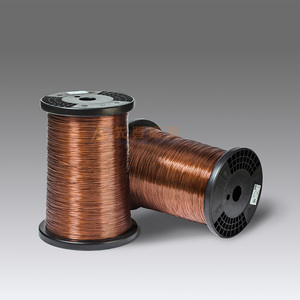The Breakthrough Of Enameled Copper Wire
Cuerpo
Enameled wire is the core material of electrical appliances. It occupies a very important position in the development of the national economy, and its market demand is great. With the continuous deepening of reform and opening up, the production technology level of the motor industry has rapidly improved, and the requirements for the quality of enameled copper wire are getting higher and higher. As far as the surface quality is concerned, before the 1990s, the enameled wire was basically not coated with lubricating oil, and only a very small number of users put forward the surface lubrication requirements (as long as they are coated to meet the requirements) using compressor oil). The introduction of advanced European and American equipment and production technology has greatly improved the production speed of domestic enameled wire and the winding speed of electrical coils; if the surface of the enameled wire is not coated with lubricating oil, wire breakage and surface damage will occur, resulting in poor coil turns , Which seriously affects the quality and service life of motors and electrical products. Therefore, relevant manufacturers have begun to pay attention to the research on the surface lubrication of the Round Enameled Copper Wire .
In the past, many factories used paraffin wax dissolved in gasoline for surface lubrication. The smoothness of the enameled wire has been greatly improved, but there are also many problems. If the solubility of paraffin wax is not good, it is easy to precipitate and cause problems: there is often a large amount of precipitation at the bottom of the barrel (especially when the temperature is low in winter); when winding, a large amount of powder is often accumulated on the felt and guide wheel, and the dripping will also cause the ground. Dirty; the amount of dissolution varies with temperature, which leads to corresponding changes in the amount of coating per unit surface area of the enameled wire, which makes the lubrication unstable; problems such as wax accumulation, bright spots on the paint surface, and frequent wire breakage are prone to occur when winding the coil. How to comprehensively consider various factors to meet the increasing lubrication requirements has become a thorny issue.
When winding, there is friction between the enameled wire and the tooling equipment (guide wheel, mold, winding machine parts, etc.), so the enameled wire itself must not only have sufficient mechanical strength, but also its surface must be as smooth as possible without any agglomeration. Fine particles. The lowest possible coefficient of friction. Only in this way can the enameled wire be smoothly wound into a tight and suitable coil; the wound coil can be quickly and completely embedded in the iron core slot of electronic components such as motors and transformers.
At present, the winding equipment of many factories is imported, which is several times faster than similar domestic equipment. Therefore, the requirements for slippage on the surface of the enameled wire are correspondingly increased. Although the international and IEC standards for enameled wire have not clearly stipulated the slippage standard (or static friction coefficient), many customers have put forward specific requirements when ordering (even rigidly stipulating the amount of lubricant per unit area), especially for export products.
New technologies in related industries involve the upgrading of such products. New types of refrigerants such as R134a, R407, and R410 are in urgent need of new materials, and technical standards (including enameled wire surface lubricants) are formulated.
In addition, environmental, labor protection laws and regulations, as well as the continuous improvement of workers' health and safety awareness, all require improvement of working conditions, and enameled wire manufacturers and their users pay more attention to the surface lubrication of enameled wires.
In recent years, some new domestic or imported enameled wire lubricants have appeared on the market. Most of them are still wax solutions; some are resin solutions, but their slipperiness is very poor. Therefore, some of the above-mentioned problems still exist in these products. So far, no ideal enameled wire lubricant products have been seen.
After more than a year and hundreds of experiments, scientists and technicians finally found an ideal technical route to synthesize small molecule materials into polymer composite functional material Q05-2, which not only solved the lubrication problem of enameled wire, but also problem. Considering many issues such as process, safety, environmental protection, cost, etc., Q05-2 is a polymer functional material modified by a special method. It is resistant to high temperature, has a lower static friction coefficient than silicone oil, and has better slipperiness. Regarding the production and use of its products, users are quite satisfied whether it is automatic winding and embedding equipment or manual embedding. The only problem is that a small number of users report that the tape is not sticky after winding into a coil (solution: 1. Stretch the tape slightly and glue the seam of the tape to fix the coil; 2. Use a plastic clip to replace the tape to fix the coil. Because The clip can be recycled, so saving money is really killing two birds with one stone).
The first thing to consider in the trial production process is the solvent problem. Most of the enameled wire lubricants currently available on the market use mineral spirits or cyclohexane as solvents (or thinners). Foreign environmental protection requirements are strict, especially the EU RoHS directive, which clearly stipulates that some prohibited substances must be selected to meet the standards. The author believes that solvent oil has better comprehensive performance, low toxicity, and low price, and it is worthy of promotion. Cyclohexane has certain physiological toxicity and high cost, so it should be controlled as far as possible. As for the use of water as a solvent, it is non-toxic and non-flammable, the author has done some explorations. Its comprehensiveness is slightly worse than that of oil-based lubricants, and it is far from a solution.
It has also been proposed to modify it with nanomaterials to further improve the slip. The author checked the information and found that under the current circumstances, some materials are not yet compatible, and some problems are still in the scientific research stage, although this is true in other types of lubricants. Some nano materials are used, but the enameled wire lubricant is still difficult due to its special circumstances.
If solvent-free lubrication can be realized, it is both environmentally friendly and safe. Some people do research and production applications abroad, but the technology is difficult and the one-time investment is high. At present, it may be difficult to realize industrialization and large-scale promotion.
At present, the surface lubricants used in the domestic enameled wire industry are mainly produced by domestic factories. Except for a small amount of imported products from Germany, the United States and Taiwan, some factories make their own preparations. From the perspective of the types of lubricants, waxes are the majority, there are also a small amount of lipids, and a small amount of synthetic lubricants, such as 05-2 enameled wire oil. Since there are thousands of wax materials with different properties, how to choose and formulate wax to have excellent comprehensive properties? Experts from all walks of life have their own magical powers, and some use synthetic materials to modify them to improve performance. As far as I know, in most cases, its slip or solubility properties are not ideal. It can be said that the dissolution of wax is very difficult. At present, the enameled wire lubricants on the market (including imported waxes) are not uniform solutions, at most they are emulsions or dispersions. Therefore, there are different degrees of precipitation during the enameled wire production process, and the static friction coefficient is relatively high. Therefore, it can be said that how to choose wax material, how to prepare it, and how to better dissolve it are the three key links in the production of wax lubricants.
Compared with wax materials, synthetic lubricants have significantly different characteristics. First, it has good solubility, and it is a uniform and transparent solution regardless of room temperature (winter). Therefore, there is no precipitation in the enameled wire guide wheel, coated felt, etc., and the surface is clean; secondly, it is smooth. When the enameled wire is about Φ0.40mm, the static friction coefficient reaches about 0.05, which is obviously better than wax lubricant. However, synthetic lubricants also require special attention. Many people currently use silicone oil to improve the lubricity of the wax. Since silicone oil has a small molecular weight and is not resistant to high temperatures, when the operating temperature of the motor is close to 150 degrees, a small amount of silicone oil will decompose to generate silicon oxide, reducing the insulation strength and causing safety accidents. Moreover, adding too much silicone oil will also affect the next process. Due to the impregnation properties, it is not recommended to use silicone oil to increase the slip of the wax. This is my personal opinion, and I want to discuss it with my colleagues.
In recent years, due to the destruction of the ozone layer and the warming of the earth, people's living environment has been seriously threatened. "Low-carbon economy" has become the common goal of people all over the world. However, various refrigeration equipment (refrigerators, air conditioners, etc.) used a large amount of Freon in the past. As a refrigerant, it has become one of the main sources of pollution, and its use is now strictly prohibited. The use of fluorine-free refrigerants is being promoted. Therefore, new requirements are put forward for the surface lubricant of the enameled wire. Because wax lubricants are incompatible with new fluorine-free refrigerants (such as R134a, R410a, R407a, etc.), if the wax lubricant is mistakenly applied to the refrigerant-resistant enameled wire, it will block the capillary of the compressor and cause a major accident. Although there are special refrigerant lubricants for L90 on the market, they have poor slippage, poor solubility, segregation, and high material prices. The introduction of Q05-2 just made up for the defects of L90 and became an ideal lubricant for cold-resistant enameled wires. A large domestic enameled wire factory began to use Q05-2 to produce refrigerant-resistant enameled wire in 2004, with a material cost of 1.5 million yuan a year. Considerable social and economic benefits.
As for the lubrication and lubricant standards of enameled wire, there is no unified standard at home and abroad. Some companies have formulated relevant internal control standards, mainly for the static friction coefficient control requirements of different wire gauges, and combined with actual hand feeling experience to determine whether they are available. Some companies also conduct dynamic and friction coefficient tests. Practice has proved that some enameled coils with the same static friction coefficient are easy to be embedded in the groove, and some are difficult. The reason is that their dynamic friction coefficients are different. The lower coefficient of dynamic friction has better embedding performance.













Comentarios